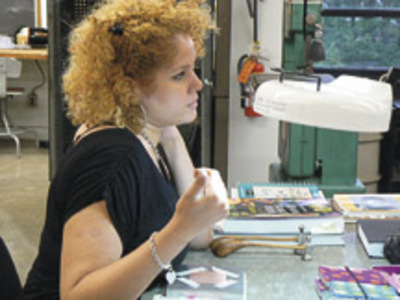“Repoussé” and “chasing” are not associated with dancing or fox hunting. Rather, they are descriptions of metalworking techniques that suggest yin and yang in harmony.
“Everything about chasing lines is about rhythm and repetition.” – Jackeline Martinez
________
And when the two come together, you have a product such as the Statue of Liberty, or on a smaller scale, the works of downtown Jersey City resident Jackeline Martinez.
Martinez, 28, is employed at an American jewelry company where she daily practices her silversmith craft known as hollowware. She especially uses the processes of repoussé and chasing to create bracelet designs with painstaking care. Some of her chasing work takes as long as 20 hours.
It was a craft she first learned while earning degrees in metalwork from SUNY-New Paltz and Kean University in Union. Learning in school combined with company training and lots of practice has made her a master in her craft.
She makes use of the tools of the trade: the chasing hammer, the chisel-like liner that is made in straight and curved shapes; planishers used for modeling; matting or texturing tools to add distinct detail, and embossers or doming tools for pushing rounded areas of metal.
Oh, and by the way, Martinez custom designs the tools that she uses, made out of water hardening tool steel.
But Martinez somehow finds time to teach others, as she did on July 20 at Kean University, where she taught members of the New Jersey Metals Arts Guild, of which she is currently vice-president.
She’s mental about metal
With her chasing hammer in hand and a sheet of metal in front of her, Martinez showed her eager pupils on the first day of the two-day class the baby steps of chasing and repoussé.
It started with a series of taps on the metal with her hammer held at a 45 degree angle to create a straight line. Not as easy it sounds, Martinez said.
“Everything about chasing lines is about rhythm and repetition,” Martinez said. “So you have to listen to what you are doing so you have the same boom, boom, boom.”
Quick to share a joke, the genial Martinez also instructed the class on some of the finer points of doing delicate metal work: get in a comfortable position, don’t move your arms and hands much, and use as much light as possible.
Martinez then showed the class the process of chasing, as she delicately tapped on the metal to form a simple, straight line. The class asked her questions as she tapped.
Martinez began to resemble the cobbler or blacksmith or an artisan of old.
“Now I am going to analyze my line before I go back and try to fix it,” Martinez said.
After she looked at her effort and checked for any blemishes, she let her class do their chasing.
She then took a break and pondered for a moment about her specialized profession.
“My work is traditional in a way, and that’s the reason I do this,” she said. “To keep the tradition alive.”
Ricardo Kaulessar can be reached at rkaulessar@hudsonreporter.com.
